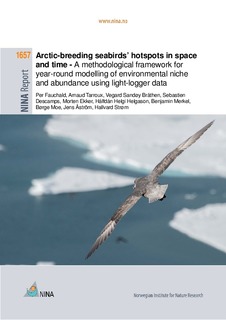| dc.description.abstract | Fauchald, P., Tarroux, A., Bråthen, V. S., Descamps, S., Ekker, M., Helgason, H. H., Merkel, B., Moe, B., Åström, J., Strøm, H. 2019. Arctic-breeding seabirds’ hotspots in space and time -a methodological framework for year-round modelling of abundance and environmen-tal niche using light-logger data. NINA Report 1657. Norwegian Institute for Nature Re-search.
By positioning a large number of seabirds throughout the year using miniaturized geoloca-tors (GLS), the SEATRACK program provides a unique dataset on the seasonal distribution of seabirds from colonies in Russia (Barents and White Seas), Norway (incl. Svalbard and Jan Mayen), Iceland, Faroe Islands and the British Isles. Combining this extensive dataset with data on population sizes has for the first time made it possible to develop seasonal estimates of the spatial distribution of Northeast Atlantic seabirds.
In this report, we document the workflow and methods used to develop monthly estimates of the distribution of seabirds from colonies covered by the SEATRACK design. The work-flow presented here consists of three steps, starting from pre-processed GLS data. First, because the position data from the loggers represent “presence-only” data, it is vital to re-move sampling biases before using the data to make interpretations of the spatial distribu-tion. Therefore, in step 1 we developed a tailored algorithm, IRMA (Informed Random Move-ment Algorithm), to reduce biases and fill gaps in the dataset due to various factors such as polar day/night, equinox and positions over land. IRMA uses available information and data to triangulate new positions and does ultimately provide a dataset where sampling biases has been reduced to a minimum. In the next step, we combined the position dataset with environmental data to model the habitat of each SEATRACK colony throughout the year. Environmental variables included remote sensing data of oceanography and primary pro-duction, and data on bathymetry. We used standard Species Distribution Models (SDM) on presence-only data to model the habitat used by each SEATRACK colony in each month. Finally, in step 3 we combined the predictions from the habitat models with available data on the populations covered by the SEATRACK design to provide predictions on seabird spatial distribution and abundance. A colony database was compiled to address the popu-lation sizes, and spatial analyses were conducted to justify a distance-rule for assigning the colonies in the colony database to the nearest SEATRACK colony. Based on the distance rule, we predicted the habitat for each colony covered by the SEATRACK design and weighted the estimates with population size. According to the distance-rule, the SEATRACK design covered from 74% to 96% of the Northeast Atlantic populations, depending on spe-cies.
Analyses and predictions were done for six common pelagic seabirds: Northern fulmar (Ful-marus glacialis), black-legged kittiwake (Rissa tridactyla), common guillemot (Uria aalge), Brünnich’s guillemot (Uria lomvia), little auk (Alle alle) and Atlantic puffin (Fratercula arctica). The resulting datasets represent monthly estimates of the number of birds from a specific breeding population in each cell of a 0.1° x 0.1° raster grid covering the entire North Atlantic. Monthly outputs were produced for each combination of species and colony, resulting in a dataset of more than 9619 raster maps. The gridded data are provided NetCDF files, one per species, and a short R-script is provided for reading, plotting and aggregating the data. An interactive mapping tool will be made available through the SEATRACK website. Appli-cations for the new tool include marine spatial planning, environmental impact- and risk as-sessments as well as assessments of seabird responses to environmental and climate change. | nb_NO |
